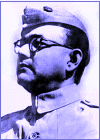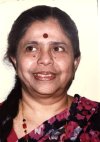Netaji Subhas Chandra Bose
by Dr. Jyotsna Kamat
First Online: January 26, 1999
Page Last Updated: December 07, 2024
While the Gandhi /Nehru
faction of Congress has garnered much of the
credit for India's freedom struggle, it is important to remember that India's freedom
movement was in fact a movement of the masses and there were a number of great leaders
with fierce patriotism and great visionary ideas who sacrificed their entire lives
for the nation's cause. We continue our series on the freedom fighters, on the occasion of
Netaji's 102nd birthday.
-Jyotsna Kamat
January 26, 1999
India's Republic Day
Subhas Chandra was born on January 23rd 1897 in Cuttack (in present day Orissa) as the ninth child among fourteen, of Janakinath Bose, an advocate, and Prabhavatidevi, a pious and God-fearing lady. A brilliant student, he topped the matriculation examination of Calcutta province and passed his B.A. in Philosophy from the Presidency College in Calcutta. He was strongly influenced by Swami Vivekananda's teachings and was known for his patriotic zeal as a student. His parents' wishes kept him away from the Indian freedom struggle and led him into studies for the Indian Civil Service in England. Although he finished those examinations also at the top of his class (4th), he could not complete his aprecentship and returned to India, being deeply disturbed by the Jallianwalla Bagh massacre. He came under the influence of Mahatma Gandhi and joined the Indian National Congress (a.k.a. Congress). Gandhiji directed him to work with Deshbandhu Chittaranjan Das, the Bengali leader whom Bose acknowledged as his political guru.
 Had he lived, Subhas Chandra Bose could have given a
new turn to Independent India's political history. But he lives on eternally in the Indian
mind, more famous after his death. Had he lived, Subhas Chandra Bose could have given a
new turn to Independent India's political history. But he lives on eternally in the Indian
mind, more famous after his death. |
Bose was outspoken in his anti-British stance and was jailed 11 (eleven) times between 1920 and 1941 for periods varying between six months and three years. He was the leader of the youth wing of the Congress Party, in the forefront of the trade union movement in India and organized Service League, another wing of Congress. He was admired for his great skills in organization development .
The Influence of Bose
Bose advocated complete freedom for India at the earliest, whereas the Congress Committee wanted it in phases, through a Dominion status. Other younger leaders including Jawaharlal Nehru supported Bose and finally at the historic Lahore Congress convention, the Congress had to adopt Poorna Swaraj (complete freedom) as its motto. Bhagat Singh's martyrdom and the inability of the Congress leaders to save his life infuriated Bose and he started a movement opposing the Gandhi-Irvin Peace Pact. He was imprisoned and expelled from India. But defying the ban, he came back to India and was imprisoned again!
Clouds of World War II were gathering fast and Bose warned the Indian people and the British against dragging India into the war and the material losses she could incur. He was elected president of the Indian National Congress twice in 1937 and in 1939, the second time defeating Gandhiji's nominee. He brought a resolution to give the British six months to hand India over to the Indians, failing which there would be a revolt. There was much opposition to his rigid stand, and he resigned from the post of president and formed a progressive group known as the Forward Block (1939).
The second World War broke out in September of 1939, and just as predicted by Bose, India was declared as a warring state (on behalf of the British) by the Governor General, without consulting Indian leaders. The Congress party was in power in seven major states and all state governments resigned in protest.
Subhas Chandra Bose now started a mass movement against utilizing Indian resources and men for the great war. To him, it made no sense to further bleed poor Indians for the sake of colonial and imperial nations. There was a tremendous response to his call and the British promptly imprisoned him . He took to a hunger-strike, and after his health deteriorated on the 11th day of fasting, he was freed and was placed under house arrest. The British were afraid of violent reactions in India, should something happen to Bose in prison.
The Mystery Begins...
Bose suddenly disappeared in the beginning of 1941 and it was not until many days that authorities realized Bose was not inside the house they were guarding! He traveled by foot, car and train and resurfaced in Kabul (now in Afghanistan), only to disappear once again. In November 1941, his broadcast from German radio sent shock waves among the British and electrified the Indian masses who realized that their leader was working on a master plan to free their motherland. It also gave fresh confidence to the revolutionaries in India who were challenging the British in many ways.
The Axis powers (mainly Germany) assured Bose military and other help to fight the British. Japan by this time had grown into another strong world power, occupying key colonies of Dutch, French, and British colonies in Asia. Bose had struck alliance with Germany and Japan. He rightly felt that his presence in the East would help his countrymen in freedom struggle and second phase of his saga began. It is told that he was last seen on land near Keil canal in Germany, in the beginning of 1943. A most hazardous journey was undertaken by him under water, covering thousands of miles, crossing enemy territories. He was in the Atlantic, the Middle East, Madagascar and the Indian ocean. Battles were being fought over land, in the air and there were mines in the sea. At one stage he traveled 400 miles in a rubber dinghy to reach a Japanese submarine, which took him to Tokyo. He was warmly received in Japan and was declared the head of the Indian army, which consisted of about 40,000 soldiers from Singapore and other eastern regions. Bose called it the Indian National Army (INA) and a government by the name "Azad Hind Government" was declared on the 21st of October 1943. INA freed the Andaman and Nicobar Islands from the British, and were renamed as Swaraj and Shaheed Islands. The Government started functioning.

Leader of Masses and the Military
Bose in INA Uniform 1943
Early Success and Tragic End
Bose wanted to free India from the Eastern front. He had taken care that Japanese interference was not present from any angle. Army leadership, administration and communications were managed only by Indians. Subhash Brigade, Azad Brigade and Gandhi Brigade were formed. INA marched through Burma and occupied Coxtown on the Indian Border. A touching scene ensued when the solders entered their 'free' motherland. Some lay down and kissed, some placed pieces of mother earth on their heads, others wept. They were now inside of India and were determined to drive out the British! Delhi Chalo (Let's march to Delhi) was the war cry.
The bombing of Hiroshima and Nagasaki changed the history of mankind. Japan had to surrender. Bose was in Singapore at that time and decided to go to Tokyo for his next course of action. Unfortunately, the plane he boarded crashed near Taipei and he died in the hospital of severe burns. He was just 48.
The Indian people were so much enamored of Bose's oratory and leadership qualities, fearlessness and mysterious adventures, that he had become a legend. They refused to believe that he died in the plane crash. The famous Red Fort trial wherein Bose's generals and the INA officers were tried, became landmark events. Initially, the British Government thought of a court-martial, but there was a countrywide protest against any kind of punishment. For common Indians, Axis and Allied powers hardly mattered, but they could not tolerate punishment of fellow countrymen who were fighting for freedom. The British Government was in no position to face open rebellion or mutiny and a general amnesty for INA soldiers was declared.
While Bose's approach to Indian freedom continues to generate heated debate in the Indian society today, there is no denying of his burning patriotism, his tireless efforts to free India from inside and outside and his reckless adventures in trying to reach his goals. His exploits later became a legend due to the many stories carried by the disbanded INA soldiers who came from every nook and corner of our great country.
Had he lived, Subhas Chandra Bose could have given a new turn to Independent India's political history. But he lives on eternally in the Indian mind, more famous after his death.
![]()

Dr. Jyotsna Kamat is a historian living in Bangalore.
India's freedom struggle is one of
her favorite topics.
![]()
See Also:
- Remembering Tilak Maharaj at Kamat's Potpourri
- Mahatma Gandhi Album at Kamat's Potpourri
- Martyrdom of Sardar Bhagat Singh at Kamat's Potpourri
- The First Indian War of Independence against British at Kamat's Potpourri
- Madam Bhikaji Cama and the First Indian Tricolor at Kamat's Potpourri
- Jyotsna Kamat's Home Page -- author's home page
- Topics in History of India at Kamat's Potpourri
- A Time-line of India at Kamat's Potpourri
- Time-Line of India's Freedom Struggle at Kamat's Potpourri
-
Biographies
External Links:
- Books
of Subhas Chandra Bose -- at Amazon


